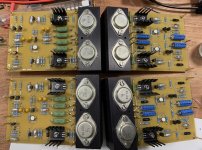Hello george,
in the previous pages you can see some picture of the boards, a work in progress footage.
Yes they are indeed a nap 140 clone boards, marked "zerozone". They have the current protection circuit (but i've not soldered it) but i strictly followed Ultima Legione scheme.
Still you can see all details in this thread, just go some pages behind this.
I'm using a toroidal with 30V secondary, so i get, without load, a plenty 44V DC, which should fall off near 40 under load.
Ultima Legione chose to rip off the rails and go with regulated supply for the VAS stage, thus ripping off the diode and the resistor he had at scheme. (not needed with separate supply)
I still got them since i run the rails with the same source, so yes i have the diode and the resistor.
For the case; you are absolutely right, having not a case is dangerous.
Unaware fingers on it, and u get things, and, worse, people, fried.
But i'm taking all the precautions i need to avoid troubles.
The 3A fuse is quite big but i kept frying them at bootstrap.
For safety reasons maybe some more fuses on DC rails are needed.
in the previous pages you can see some picture of the boards, a work in progress footage.
Yes they are indeed a nap 140 clone boards, marked "zerozone". They have the current protection circuit (but i've not soldered it) but i strictly followed Ultima Legione scheme.
Still you can see all details in this thread, just go some pages behind this.
I'm using a toroidal with 30V secondary, so i get, without load, a plenty 44V DC, which should fall off near 40 under load.
Ultima Legione chose to rip off the rails and go with regulated supply for the VAS stage, thus ripping off the diode and the resistor he had at scheme. (not needed with separate supply)
I still got them since i run the rails with the same source, so yes i have the diode and the resistor.
For the case; you are absolutely right, having not a case is dangerous.
Unaware fingers on it, and u get things, and, worse, people, fried.
But i'm taking all the precautions i need to avoid troubles.
The 3A fuse is quite big but i kept frying them at bootstrap.
For safety reasons maybe some more fuses on DC rails are needed.
@Ian
In your previous posts you mentioned a " pr&t" effect.
Can you explain what is it? I can't even guess the acronym's words hehe
In your previous posts you mentioned a " pr&t" effect.
Can you explain what is it? I can't even guess the acronym's words hehe
Pace, rhythm and timing.
It makes you want to tap your foot to the music.
It’s like how you can tell a band is playing well together...has tight timing.
It makes you want to tap your foot to the music.
It’s like how you can tell a band is playing well together...has tight timing.
Hi, in around red circle you should put a smal round bridge 1,5A rectifire, in the other red marked, sorry but I dont know 🙂, maibe you have to see the electronic diagram.
Regards
these parts are obviously for the 24V preamp supply - do not use them if you do not need this supply
Fair question. PR&T (also PRAT) is well known amongst British Naim fans but I had a similar reaction as yours, about 40 years ago when I saw the words in a British HiFi magazine quoting Julian Vereker, the founder, designer and CEO of Naim Audio. He used the terms Pace, Rhythm and Timing to describe important Naim sound qualities. They refer to a snappy sound effect which slightly emphasises those qualities of pop music. It means people feel more inclined to tap their toes, dance about and join with the music - all good effects for music lovers@Ian.....In your previous posts you mentioned a " pr&t" effect.....Can you explain what is it? I can't even guess the acronym's words hehe

Well I can assure you that as per Ultima Legione's specs, the circuit he crafted has indeed a ton of PRAT.
My realization maybe lacks something in the subtle details, it miss something in the micro dinamics, but it is indeed a great sounding machine.
Ear tested with a dartzeel nhb 108 clone, just crafted by a friend.
The nhb108 do sound more natural, having all the possible details found in the recording smashed up onto your face.
But...
Lifelessly.
That swiss amp is #1 where you can appreciate clarity of voices and single to few instruments, maybe live records.
But naim wins hands off, for "studio" music
My realization maybe lacks something in the subtle details, it miss something in the micro dinamics, but it is indeed a great sounding machine.
Ear tested with a dartzeel nhb 108 clone, just crafted by a friend.
The nhb108 do sound more natural, having all the possible details found in the recording smashed up onto your face.
But...
Lifelessly.
That swiss amp is #1 where you can appreciate clarity of voices and single to few instruments, maybe live records.
But naim wins hands off, for "studio" music
Not to be misunderstood, the two circuits give you a great sound. Both.
But the greatness of stereo image given by the naim clone is HUGE and it is indeed a "game changer". Makes you forget all the rest.
As always, all of this is personal subjective judgment.
But the greatness of stereo image given by the naim clone is HUGE and it is indeed a "game changer". Makes you forget all the rest.
As always, all of this is personal subjective judgment.
Ok fuse switched i have one channel working at 38 mA which seem fine, however dc offset is 0.09 vwhich seem too high, will this be an issue and if so how can i reduce it?
It's not too bad. Work out the speaker current, about 1mW heat if my maths correct. The Naim input stage is likely to be slight worse than most. This seems to be an attempt at single transistor distortion and twin transistor DC point advantages of a long tail pair. That is the distortion of the Quad 303 which I beleive was known to the designer.
A matched pair of input transistors might help.
Ok fuse switched i have one channel working at 38 mA which seem fine, however dc offset is 0.09 vwhich seem too high, will this be an issue and if so how can i reduce it?
It's not too bad. Work out the speaker current, about 1mW heat if my maths correct. The Naim input stage is likely to be slight worse than most. This seems to be an attempt at single transistor distortion and twin transistor DC point advantages of a long tail pair. That is the distortion of the Quad 303 which I beleive was known to the designer.
A matched pair of input transistors might help.
0.09v is 9mV - probably a tiny bit high but absolutely fine.
You need to stary worrying when you have 50mV+ offset.
EDIT: The multiquote doesn't seem to work? (had to add the other quote manually)
I was just checking that you guys were awake 🙂
OOPS 90mV !!
Yeah that is a bit high for DC offset - my mistake!!!
Hi everyone,
made a 4th complete build lol.....
Basically, it has the H-140(ebay clone) front-ending sound signature with the naim favored 22k1k harmonics 😉
If H-140 did sound periodically "cool😱", then this amplifier sounds ALWAYS "cool😱😱😱" after about 5-10mins from the cold start. It all depends on how cold is the room.
Rhythm and time are the strongest points in that amplifier.
Space is "front-ending" and gives you that "big speaker" feeling. (listening from FRS8 needles). Like an instrument in quitar, piano programs.
There are lots of factors that must be met to make it less "fatigue" sounding.
3 of these i consider the most important:
The very first and very worst enemy is the temperatureIt comes and goes @ various rates and affects every active component used. I came to a conclusion that naim amplifier depends on that factor massively. Especially if you design your amplifiers in free-air temperature "without the case" - it would be a fail design 100% not considering lucky situations. Every case needs its own amplifier adjustments... that is why some think that case has a "sound" 😀
The second factor is that you have to determine, which one of the boards will be your left and your right channel... and then go designing from that point. If you make 100% same boards that have resistors, transistors, capacitors, currents and theyr offsets all the same, it again will be 100% fail design as from my previous experiences.
Third one is based on exp. gained while doing this stuff as a hobby. One must be able to manipulate with the sound signature and its space with in the head to get an idea what is the acoustic result if some sort of change is applied in electrical circuit lol....then the phase shift networks, different dc offsets and currents will give you an idea that what it does to acoustics and its space. For example, starting with the speakers... aligning them perfectly in a room. I used cyborgs needle FRS8 speakers...(there are some bad FRS8 elements on sale, be aware).
To my surprise, the component choice is not at all that critical after all. For example... it can be made without the ZTX, BC239, MJE and Sanken series transistors, as in my last case. I didnt use any of those cuz they are pretty much outdated. My current boards have approximately 20mA of bias @ outputs.
The very basic idea is that you have to make boards a little bit different and in the same time be within the design margin. How much difference depends on the length and cable arrangement used, boards placement in the case and everything else.
I think, all amplifiers do need some sort of difference to some extent for a great loving sound.
Also, in my case, there are some critical design criteria involved with in the boards... perhaps cuz of the transistors i used in that circuit....and i really really love how TIP handles 2SC5200... its just blows my mind out into space 😀
I havent driven my BIG Eminence 10" speakers with 4th amplifier yet.... had to lend them out for some time(they are all original, even filter are).
Video about good and strange FRS8:
RIGHT ONE IS GOOD WITH NICE HIGHS, easier to move cone(more relaxed)
LEFT ONE IS ALSO GOOD BUT HIGHS ARE STRANGE, not cool imo. Speaker cone is more stiff.
FRS8 vs FRS8 - YouTube
Sometimes you get a feeling that its all about 2 capacitors used in the circuit(FB and BIAS, The Dictators) and everything else comes later.
It would be nice to have some evidence of various designs... some sort of visualization lol..😎
made a 4th complete build lol.....
Basically, it has the H-140(ebay clone) front-ending sound signature with the naim favored 22k1k harmonics 😉
If H-140 did sound periodically "cool😱", then this amplifier sounds ALWAYS "cool😱😱😱" after about 5-10mins from the cold start. It all depends on how cold is the room.
Rhythm and time are the strongest points in that amplifier.
Space is "front-ending" and gives you that "big speaker" feeling. (listening from FRS8 needles). Like an instrument in quitar, piano programs.
There are lots of factors that must be met to make it less "fatigue" sounding.
3 of these i consider the most important:
The very first and very worst enemy is the temperatureIt comes and goes @ various rates and affects every active component used. I came to a conclusion that naim amplifier depends on that factor massively. Especially if you design your amplifiers in free-air temperature "without the case" - it would be a fail design 100% not considering lucky situations. Every case needs its own amplifier adjustments... that is why some think that case has a "sound" 😀
The second factor is that you have to determine, which one of the boards will be your left and your right channel... and then go designing from that point. If you make 100% same boards that have resistors, transistors, capacitors, currents and theyr offsets all the same, it again will be 100% fail design as from my previous experiences.
Third one is based on exp. gained while doing this stuff as a hobby. One must be able to manipulate with the sound signature and its space with in the head to get an idea what is the acoustic result if some sort of change is applied in electrical circuit lol....then the phase shift networks, different dc offsets and currents will give you an idea that what it does to acoustics and its space. For example, starting with the speakers... aligning them perfectly in a room. I used cyborgs needle FRS8 speakers...(there are some bad FRS8 elements on sale, be aware).
To my surprise, the component choice is not at all that critical after all. For example... it can be made without the ZTX, BC239, MJE and Sanken series transistors, as in my last case. I didnt use any of those cuz they are pretty much outdated. My current boards have approximately 20mA of bias @ outputs.
The very basic idea is that you have to make boards a little bit different and in the same time be within the design margin. How much difference depends on the length and cable arrangement used, boards placement in the case and everything else.
I think, all amplifiers do need some sort of difference to some extent for a great loving sound.
Also, in my case, there are some critical design criteria involved with in the boards... perhaps cuz of the transistors i used in that circuit....and i really really love how TIP handles 2SC5200... its just blows my mind out into space 😀
I havent driven my BIG Eminence 10" speakers with 4th amplifier yet.... had to lend them out for some time(they are all original, even filter are).
Video about good and strange FRS8:
RIGHT ONE IS GOOD WITH NICE HIGHS, easier to move cone(more relaxed)
LEFT ONE IS ALSO GOOD BUT HIGHS ARE STRANGE, not cool imo. Speaker cone is more stiff.
FRS8 vs FRS8 - YouTube
Sometimes you get a feeling that its all about 2 capacitors used in the circuit(FB and BIAS, The Dictators) and everything else comes later.
It would be nice to have some evidence of various designs... some sort of visualization lol..😎
Attachments
-
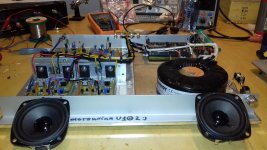 20200801_195838.jpg568.7 KB · Views: 477
20200801_195838.jpg568.7 KB · Views: 477 -
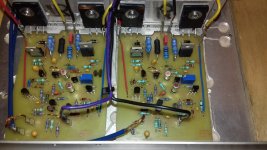 20200801_200028.jpg595.1 KB · Views: 487
20200801_200028.jpg595.1 KB · Views: 487 -
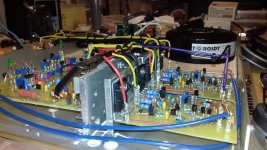 20200801_200039.jpg592.3 KB · Views: 474
20200801_200039.jpg592.3 KB · Views: 474 -
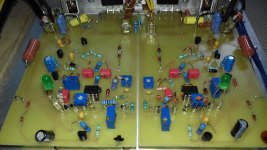 20200801_190225.jpg530.9 KB · Views: 469
20200801_190225.jpg530.9 KB · Views: 469 -
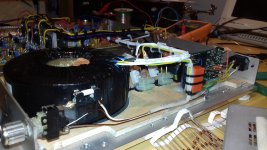 20200801_200145.jpg528.6 KB · Views: 199
20200801_200145.jpg528.6 KB · Views: 199 -
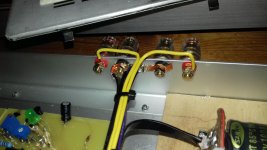 20200801_184916.jpg523 KB · Views: 453
20200801_184916.jpg523 KB · Views: 453 -
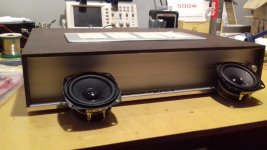 20200801_200311.jpg404.1 KB · Views: 201
20200801_200311.jpg404.1 KB · Views: 201 -
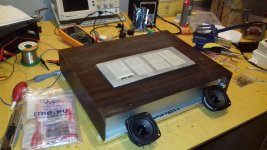 20200801_200335.jpg516.1 KB · Views: 201
20200801_200335.jpg516.1 KB · Views: 201 -
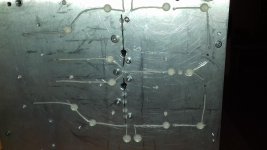 20200801_200446.jpg459.4 KB · Views: 211
20200801_200446.jpg459.4 KB · Views: 211 -
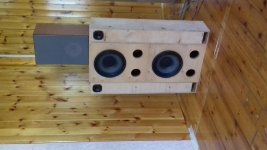 20200509_111448.jpg376.5 KB · Views: 207
20200509_111448.jpg376.5 KB · Views: 207
Last edited:
REALLY nice job rensli. A lot of work and effort in there.. but i'm sure satisfaction is in your hands 🙂
Let me ask you some now......
1) i see a volume control. a passive one? can you give us some infos?
2) FRS8. why this model? is it special? good quality/price?
Regarding the Naim circuit: yes, i can confirm that temperature control is critical. Since this amp doesn't need SO MUCH heat dissipation, a "semi-closed" enclosure with any fans is probably the best solution. There you can have that useful "heat intertia" that naim circuit needs to stabilize itself.
The active components: well i have two builds now, one with Ultima Legione specs, and one with sankens and ztx.
Both of them has sonic footprint.
Still can't tell the differences, because the second build has a "poor's man" power supply stage, so there can be NO tests between them.
Last point (for now) isn't better to use non-inductive 0.22 resistors for the final stage?
Let me ask you some now......
1) i see a volume control. a passive one? can you give us some infos?
2) FRS8. why this model? is it special? good quality/price?
Regarding the Naim circuit: yes, i can confirm that temperature control is critical. Since this amp doesn't need SO MUCH heat dissipation, a "semi-closed" enclosure with any fans is probably the best solution. There you can have that useful "heat intertia" that naim circuit needs to stabilize itself.
The active components: well i have two builds now, one with Ultima Legione specs, and one with sankens and ztx.
Both of them has sonic footprint.
Still can't tell the differences, because the second build has a "poor's man" power supply stage, so there can be NO tests between them.
Last point (for now) isn't better to use non-inductive 0.22 resistors for the final stage?
Last point (for now) isn't better to use non-inductive 0.22 resistors for the final stage?
It depends lol, i think alot on the wiring arrangement and material you mount your transistors for cooling (siliconpad, ceramic pad, thickness and so on).
I my case, simple non-inductive 0.22 OHM just wont work.
Be aware of emitter resistance.... there is something going on with the feedback.... less is cool, but not at the same time in this topology 😀 Careful here. drivers and output dependent
I just Love, how this amp turns small speakers into LIVE action...
see a volume control
Its a switching powersupply lol(small board, vertically mounted on glue), i need it for PSU.... amp has regulator boards.
FRS8
They cost 16€ and give 100€ speaker expression with naim amp 😀 And its a TQWT design, you can hear everything from there in a ~ 15m2 room.
Last edited:
The Naim design is border-line unstable. I think you definitely want a little bit of inductance in the output stage.
I would agree with that.
This is why Naim specified that people use their own cable, as their cable made the amps more stable.
And IIRC Naim themselves also used a wirewound resistor in series with the output.
Yep, they are kinda unstable, but its not only the outputstage that is responsible for this kind of behaviour .
Its almost impossible or very hard to build it that way, limited resources are the problem. I would definitely love to bruto force the design.
It means 100+ completed boards with a little difference to each other.
My capacitor specs are left unchecked, it too must be suited correctly, depends on the dc offsets at the output.
Caps are very hard to get for a naim, tants.
Its almost impossible or very hard to build it that way, limited resources are the problem. I would definitely love to bruto force the design.
It means 100+ completed boards with a little difference to each other.
My capacitor specs are left unchecked, it too must be suited correctly, depends on the dc offsets at the output.
Caps are very hard to get for a naim, tants.
Guys,
Have you ever thought that all components must be warmed and cooled @ at the same rate or an X rate for low distortion, passive ones also.
I don't even recognize a good or a bad component anymore... It has something to do with thermal performance throughout this design!!
For example, Dale has its thickness of coating for its components , philips has its own...it varies from series of products but it matters the most🙁
Thats why its almost always better to use only 1 brand of components.
There are some instances where we want to introduce some difference for audio channels to make them behave.......
Thats just crazy omg... I had to go pretty low Icurrent on VAS and DRIVERS for more-linear stable performance in this wooden case. I couldn't play @ high volumes for more then 10 minutes... it gets some fatigue... after some cooling, it gets good and fresh again...
I have to thank the regulator BOARDS that opened up this amplifier boards for the first time omg.... with regulators... its easy to detect acoustically perhaps every change you make to audio boards.
All i can say that this AMP with regulators is 1000000% more scientific and cool then without regulation 😛😛 EDIT: AND ITS SAFER TOO 🙂
I really Strongly do not recommend to modify this amplifier boards in any way ! If you buy a kit from ebay, solder it and leave it as it is... you wont EVER make anything better by decoupling, lovering DC offsets or whatever lol
These things originally sing so good if everything is taken care of 😀 LESS components = MORE WIN
Its a critical design and if some small change is missed, welcome fatigue forever!
Have you ever thought that all components must be warmed and cooled @ at the same rate or an X rate for low distortion, passive ones also.
I don't even recognize a good or a bad component anymore... It has something to do with thermal performance throughout this design!!
For example, Dale has its thickness of coating for its components , philips has its own...it varies from series of products but it matters the most🙁
Thats why its almost always better to use only 1 brand of components.
There are some instances where we want to introduce some difference for audio channels to make them behave.......
Thats just crazy omg... I had to go pretty low Icurrent on VAS and DRIVERS for more-linear stable performance in this wooden case. I couldn't play @ high volumes for more then 10 minutes... it gets some fatigue... after some cooling, it gets good and fresh again...
I have to thank the regulator BOARDS that opened up this amplifier boards for the first time omg.... with regulators... its easy to detect acoustically perhaps every change you make to audio boards.
All i can say that this AMP with regulators is 1000000% more scientific and cool then without regulation 😛😛 EDIT: AND ITS SAFER TOO 🙂
I really Strongly do not recommend to modify this amplifier boards in any way ! If you buy a kit from ebay, solder it and leave it as it is... you wont EVER make anything better by decoupling, lovering DC offsets or whatever lol
These things originally sing so good if everything is taken care of 😀 LESS components = MORE WIN

Its a critical design and if some small change is missed, welcome fatigue forever!
Last edited:
- Home
- Amplifiers
- Solid State
- NAP-140 Clone Amp Kit on eBay

